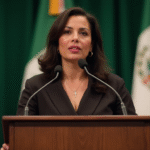Introduction to Clara Brugada’s “Utopías” Project
Since assuming the role of Head of Government in Mexico City, Clara Brugada has embarked on a six-year project to construct 100 parks and community centers for sports, arts, and culture. Dubbed “Utopías,” these centers aim to foster inclusive social harmony, though critics argue the concept is overly idealistic.
The Positive Aspects of Brugada’s Initiative
On the surface, Brugada’s plan to establish centers for cultural, sports, and artistic activities among the youth is commendable. Such initiatives could potentially combat crime and other social issues. However, a significant challenge lies in identifying suitable locations for these centers.
A more pragmatic approach would involve reviewing existing community centers in each borough and enhancing their facilities before proposing new constructions.
Resistance to “Utopías” in Xochimilco and Álvaro Obregón
In the boroughs of Xochimilco and Álvaro Obregón, residents have opposed the implementation of “Utopías.” Newly elected Alcalde Javier López Casarín, whose victory is questionable, announced plans to build a “Utopía” in Parque Japón—a large green space already equipped with walking paths, football, tennis, and basketball courts, an event area, and more.
Local residents associations immediately pointed out the impracticality of this project, citing potential tree felling, traffic complications, increased water consumption, and the successful existing activities in Parque Japón.
Controversial “Consulta Popular” for the Parque Japón Utopía
Despite community opposition, López Casarín and Brugada persisted, promising a “popular consultation” for the majority’s decision. Unfortunately, residents fell for this tactic, as Morena is known for its flawed and manipulated consultations.
On September 14, the “voting” process was riddled with irregularities: no proper voter registry, unclear selection of poll workers, lack of indelible ink, and denial of voting rights based on false claims of residency in other colonias. Moreover, taxis were used to transport “acarreados” (transported voters) between polling stations, blatantly practicing “carrusel” voting.
López Casarín celebrated a dubious 70% approval rate from the alleged 5,300 voters, a clearly manipulated and fraudulent outcome.
Why the Persistence in Building Parque Japón’s Utopía?
López Casarín’s insistence on the Parque Japón project stems from the opportunity it presents for a politician to manipulate public resources. A genuinely concerned Alcalde would prioritize addressing the borough’s pressing issues, such as potholes, traffic, insecurity, lighting, clogged drains, water leaks, waste management, transportation, and more.
Instead of focusing on these critical matters, López Casarín seeks to impose a dubious social and ecological return project that serves his personal interests. Sir, if you genuinely care for your constituents, listen to us attentively.
Key Questions and Answers
- What is Clara Brugada’s “Utopías” project? It’s a plan to build 100 community centers for sports, arts, and culture across Mexico City.
- Why is there resistance to “Utopías” in Álvaro Obregón? Residents oppose the proposed construction of a “Utopía” in Parque Japón, citing practical concerns and existing successful activities.
- What happened during the “popular consultation” for Parque Japón’s Utopía? The voting process was marred by irregularities, including lack of voter registry, unclear selection of poll workers, and transportation of voters between polling stations.
- Why are people questioning López Casarín’s priorities? Critics argue that the Alcalde should focus on addressing pressing issues in Álvaro Obregón, such as potholes, traffic, and security, rather than pursuing a controversial “Utopía” project.






